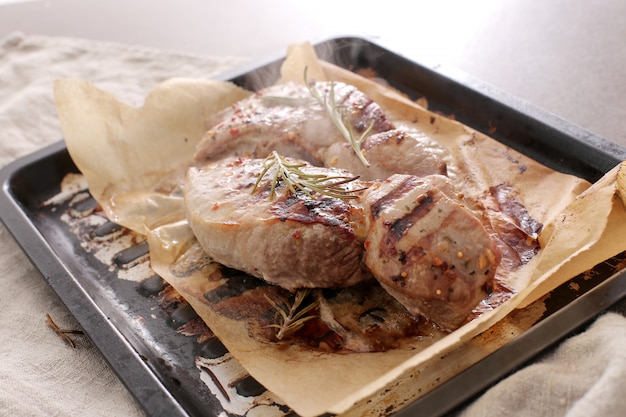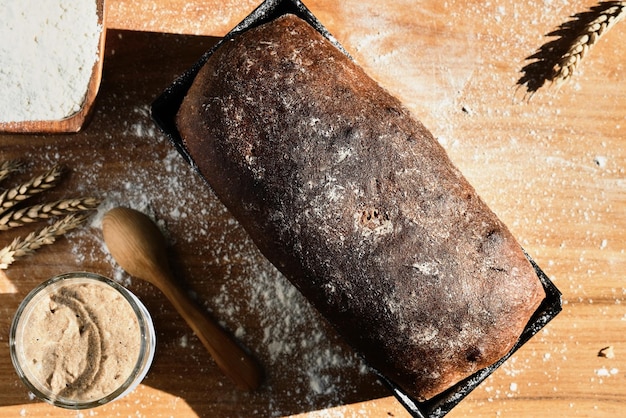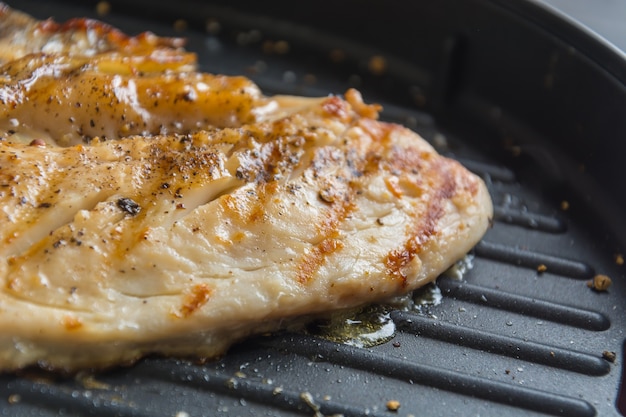Ah, pork tenderloin. That beautiful, lean cut of meat that’s become a favourite for many cooks, myself included. It’s versatile, quick to cook, and when done right, absolutely divine. But let's be honest, there's a bit of a learning curve when it comes to pork tenderloin. One minute it’s juicy and tender, the next it’s dry and tough. And no one wants that, right?
So, over the years, I’ve tried a fair few methods, experimented, learned, and finally, I've developed a system that guarantees a perfect pork tenderloin every time. And I'm delighted to share it with you. We'll cover everything from choosing the right tenderloin to the best cooking method, all the way to the perfect resting time. Ready to become a pork tenderloin master? Let's get started.
Choosing the Perfect Pork Tenderloin

(Part 1)
The Butcher’s Choice
First things first, let's talk about picking the right tenderloin. Now, I’m not a butcher, but I've been to enough butchers and supermarkets to know a good one when I see one. When you're picking a pork tenderloin, you want one that’s firm, not too pale, and free of any discoloration. A nice, even pink colour is what you're looking for, and the fat should be well-marbled.
You know what they say, you get what you pay for. If you can find a tenderloin from a local butcher, all the better. They usually have the best quality, and they’re often happy to give you a bit of advice on cooking it. But if you’re shopping in a supermarket, don’t be afraid to ask the staff for help. They usually have a good knowledge of their products, too.
Size Matters
Another thing to consider is size. I usually opt for a tenderloin that’s about 1 to 1.5 pounds. It’s just the right size for a couple of people or a small family. If you're feeding a larger crowd, you might want to pick up two tenderloins. And don’t worry about them being different sizes. You can cook them together perfectly well.
The Trim
Now, sometimes you'll get a tenderloin that has a bit of fat on it. Don't be afraid to trim it off. A little bit of fat is good, but too much can make the tenderloin greasy. Just use a sharp knife and remove any excess fat.
Prepping the Pork Tenderloin

(Part 2)
The Rinse and Pat Dry
Okay, so you've got your perfect pork tenderloin. The next step is to give it a quick rinse under cold water. Then, pat it dry with some kitchen paper. You want the tenderloin to be dry so it browns nicely and the seasoning adheres well.
Seasoning Secrets
Now, here’s where things get fun. There are a million ways to season a pork tenderloin. I love experimenting with different flavour profiles. My personal favourite is a simple combination of salt, pepper, and garlic powder. It's classic for a reason! But you can get really creative with it. You can add herbs like rosemary, thyme, or sage. Spices like paprika, cumin, or chili powder can really spice things up. And don’t forget about the citrus! A squeeze of lemon or orange juice can really brighten up the flavour.
Don’t Forget the Rub
If you're feeling fancy, try making your own spice rub. It's really easy, and you can tailor it to your tastes. Simply mix together your favourite herbs and spices, and then rub it all over the tenderloin. For an extra touch of flavour, you can even add some brown sugar for a bit of sweetness.
The Roast
Now, here’s the key to a perfectly cooked pork tenderloin. You're going to want to roast it. It’s the best way to get it tender and juicy.
Oven-Roasting the Pork Tenderloin

(Part 3)
Preheat Your Oven
Before you start cooking, preheat your oven to 400°F (200°C). This ensures the tenderloin cooks evenly and quickly.
The roasting pan
You can use a roasting pan, a baking dish, or even a cast iron skillet. The important thing is to make sure it’s large enough to hold the tenderloin comfortably.
Don't Overcrowd
If you're cooking multiple tenderloins, don't overcrowd the pan. Leave a little space between them so they cook evenly.
The Roast
Place the seasoned tenderloin in the preheated oven and roast for 20-25 minutes, or until the internal temperature reaches 145°F (63°C). You can use a meat thermometer to check the temperature.
Resting is Key
(Part 4)
The Crucial Step
Once the tenderloin is cooked, take it out of the oven and let it rest for 10-15 minutes before slicing. This allows the juices to redistribute, resulting in a more tender and flavorful piece of meat. You can cover it loosely with foil to keep it warm while it rests.
How to Determine Doneness
(Part 5)
The Thermometer Test
As I mentioned, a meat thermometer is your best friend when cooking pork tenderloin. It ensures that it’s cooked to the right temperature.
Other Ways
But if you don't have a thermometer, there are other ways to tell if the tenderloin is done. The meat should be firm to the touch, and the juices should run clear when you cut into it.
Cooking Times
(Part 6)
Cooking Time Chart
Okay, so you've got your tenderloin prepped and ready to go. Now, let's talk about cooking times. Here's a handy chart that shows you how long to cook a pork tenderloin based on its weight:
| Weight | Cooking Time |
|---|---|
| 1 pound | 20-25 minutes |
| 1.5 pounds | 25-30 minutes |
| 2 pounds | 30-35 minutes |
Adjust for Thickness
Keep in mind that these are just guidelines. The cooking time can vary depending on the thickness of the tenderloin. If you have a thick tenderloin, you may need to cook it for a little longer.
Different Cooking Methods
(Part 7)
Pan-Seared
For a crispy exterior and juicy interior, you can try pan-searing the tenderloin before roasting. Simply heat a heavy-bottomed skillet over medium-high heat, add a bit of oil, and sear the tenderloin for 2-3 minutes per side. Then transfer it to the oven and continue roasting as usual. This method creates a beautiful crust on the outside, while the oven does the rest of the work to cook it through.
slow cooker
If you prefer a hands-off approach, you can cook pork tenderloin in a slow cooker. Simply place the seasoned tenderloin in the slow cooker, add a cup of liquid (such as chicken broth or apple juice), and cook on low for 4-6 hours, or on high for 2-3 hours. The slow cooker method results in a tender, melt-in-your-mouth pork tenderloin, perfect for a busy weeknight.
flavorful pork tenderloin Recipes
(Part 8)
Honey Garlic Pork Tenderloin
This recipe is simple, delicious, and a crowd-pleaser. Combine honey, soy sauce, garlic, and ginger, and coat the tenderloin. Roast until cooked through, and enjoy with a side of rice or mashed potatoes. The sweet and savoury flavours of this recipe make it a true winner.
Apple Cider Pork Tenderloin
For a fall-inspired dish, try this recipe. Marinate the tenderloin in apple cider, Dijon mustard, and herbs. Roast until cooked through, and serve with a side of roasted apples and Brussels sprouts. This recipe is perfect for the cooler months, with its warm and comforting flavours.
Lemon Herb Pork Tenderloin
This recipe is light and refreshing, perfect for a summer meal. Combine lemon juice, fresh herbs, and garlic, and marinate the tenderloin. Roast until cooked through, and serve with a side of roasted vegetables. The zesty lemon and aromatic herbs make for a beautiful and flavourful dish.
FAQs
(Part 9)
What’s the Best Way to Serve Pork Tenderloin?
Pork tenderloin is incredibly versatile. It's delicious on its own, but it pairs well with a variety of sides. Some of my favourites include:
Roasted vegetables: Roasted vegetables like asparagus, broccoli, or carrots add a touch of freshness and colour to the dish.
Mashed potatoes: creamy mashed potatoes are a classic comfort food pairing that complements the tenderloin beautifully.
Rice: A simple side of rice is always a good choice, especially with a honey garlic or apple cider pork tenderloin.
Quinoa: For a lighter and more nutritious option, quinoa is a great choice.
Salad: A refreshing salad can balance out the richness of the pork tenderloin.
Can I Freeze Pork Tenderloin?
Yes, you can freeze pork tenderloin for up to 3 months. Simply wrap it tightly in plastic wrap and then place it in a freezer-safe bag. Make sure to thaw it completely in the refrigerator before cooking.
How Do I Tell If Pork Tenderloin is Undercooked?
The best way to tell if pork tenderloin is undercooked is by using a meat thermometer. If the internal temperature is below 145°F (63°C), it's not safe to eat. Undercooked pork can carry harmful bacteria.
How Do I Reheat Pork Tenderloin?
To reheat pork tenderloin, you can use the oven, stovetop, or microwave. If you're using the oven, preheat it to 350°F (175°C) and reheat the tenderloin for 15-20 minutes. If you're using the stovetop, heat a skillet over medium heat and reheat the tenderloin for 5-7 minutes. If you're using the microwave, reheat the tenderloin on high for 1-2 minutes.
What Should I Do if the Pork Tenderloin is Overcooked?
If the pork tenderloin is overcooked, it will be dry and tough. You can try to salvage it by adding a sauce or gravy. But sometimes, it's better to just admit defeat and make something else.
Everyone is watching

Corn on the Cob: The Ultimate Guide to Perfectly Cooked Ears
Healthy MealsAh, corn on the cob. Just the name evokes images of sunny days, barbecues, and that sweet, juicy flavour that ...

Perfect Pork Roast Oven Cooking Time: A Guide to Delicious Results
Healthy MealsThere's something truly satisfying about a perfectly roasted pork. The aroma alone is enough to make your mout...

Ham Cooking Time: How Long to Bake, Smoke, or Boil a Delicious Ham
Healthy MealsAh, ham. It's a classic, isn't it? A real crowd-pleaser, especially around holidays. And when done right, it'...

Scallops: The Ultimate Guide to Perfect Cooking
Healthy MealsAh, scallops. Those delicate, sweet, and utterly delicious morsels of the sea. They hold a special place in my...

Spaghetti Squash: The Ultimate Guide to Cooking and Serving
Healthy MealsRemember that time you saw spaghetti squash at the supermarket, looking all bumpy and strange, and thought, "W...
